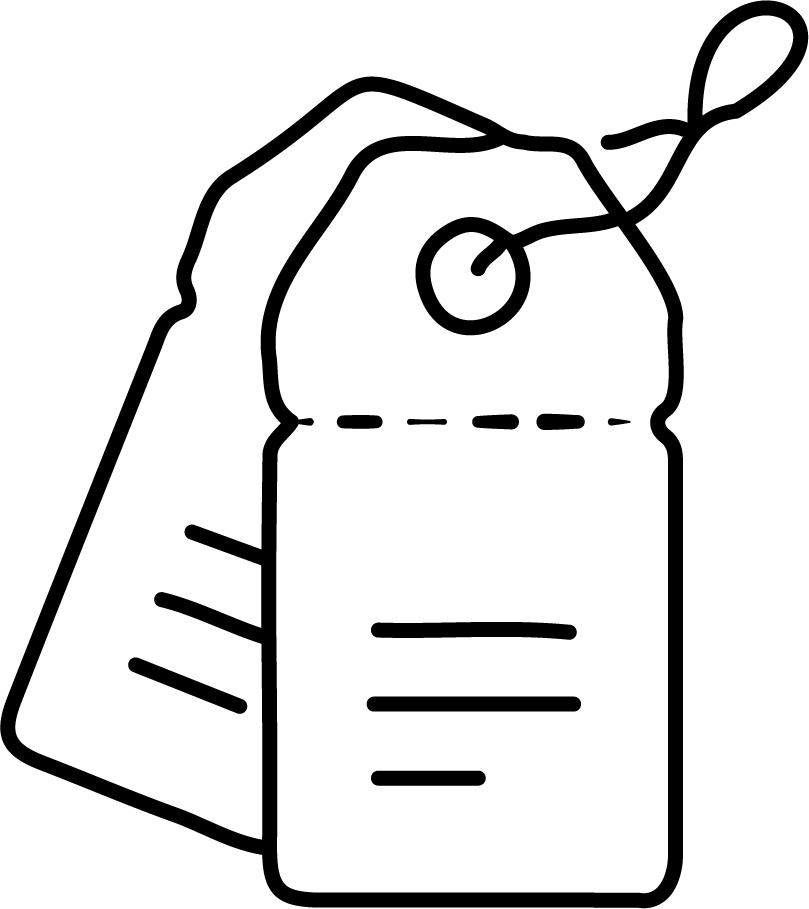Buying a knife set can be complicated. The answers can be hidden behind some terminology most of us don’t even recognize. There’s metallurgy, chromium, carbon, molybdenum. There’s a Rockwell scale? Don’t worry. We’ll try to make sense of most of it for you. But be assured, the most important things to consider are how do they feel in your hand, do you like the way they look, are they going to match your budget and be durable enough for your lifestyle? After that you just need to determine whether or not you need a few knives or a knife block set. Let's get started.
1. What knives do I actually need?
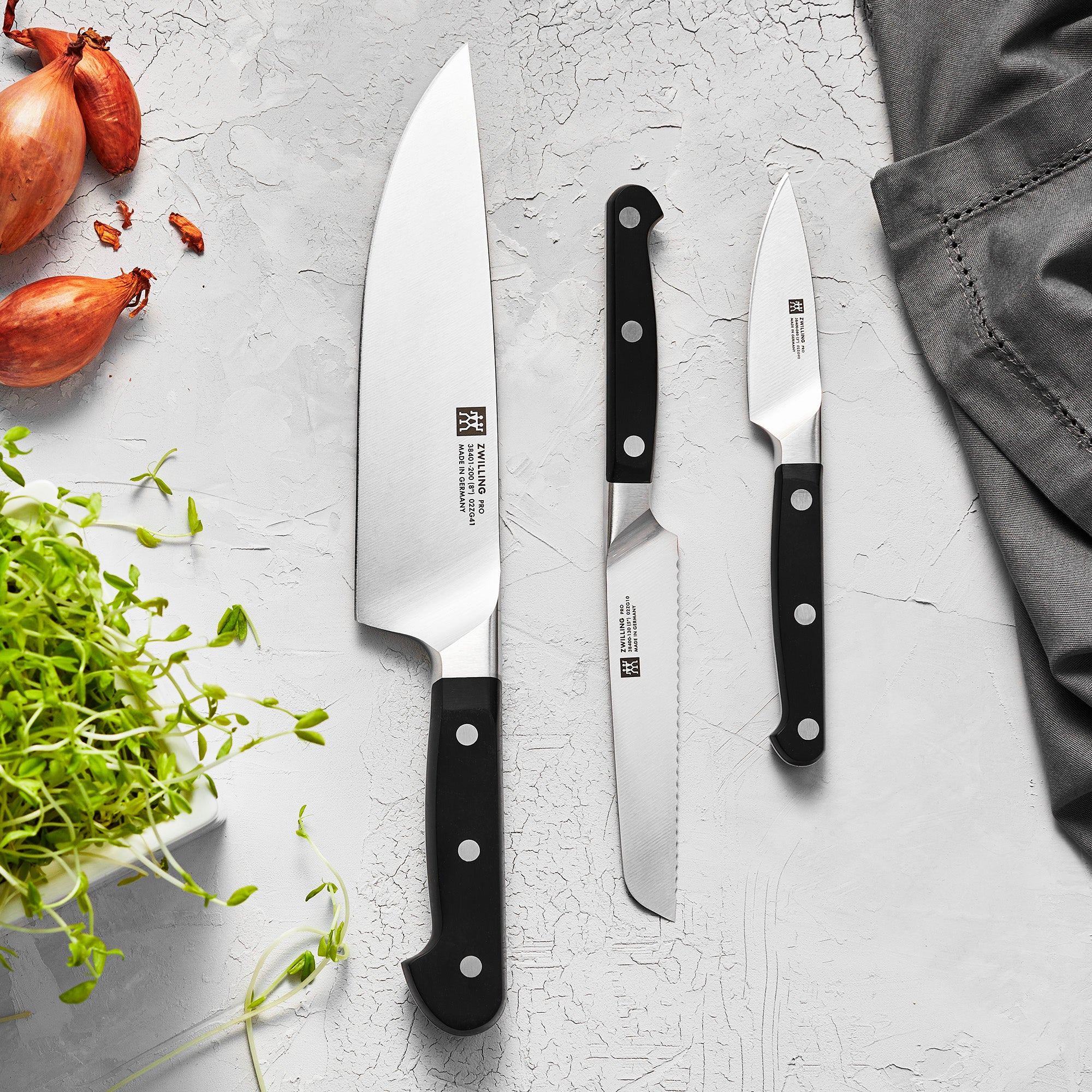
Chef’s knife.
Every self-respecting chef should start with what most of the world just refers to as a chef’s knife. Good thing they called it that. The definition of a chef’s knife can vary greatly from chef to chef. There are Western and Eastern chef’s knives that can be distinguished, in the simplest of ways, by blade bevel sharpness. Because of their lower blade bevel 10-15%, Eastern chef’s knives are perceived to be sharper compared to Western’s bevel at 20% plus. Eastern chef’s knives also can have different bevels on each side of the blade. While most Western chef’s knives have a uniform bevel on both sides known as a double bevel. But like most consumer products the lines get a little blurry. Chef’s knives, both Western and Eastern come in anywhere between 8ish-14ish inches. Eastern knives tend to be a little shorter, more agile and lightweight.
Western knives are usually thought of as a rocking knife. As you would normally rock back and forth on the curved blade edge for a large portion of your cuts. Eastern knives are perceived as more slicing knives. Let’s put it this way. Japanese manufacturers make Western chef’s knives and German manufacturers make a chef’s knife called a Santoku knife that shares some similarities with an Eastern chef’s knife. Most notably, the dimples or indentations on the blade. Those are called granton or granton edge. Those dimples try their best to keep veggies or dense foods from sticking to the blade. However, the jury is still out on that one. But try your best to not be like us, and get too hung up on the differences in chef’s knives. It is a must have.
Bread knife or serrated knife.
This is usually a longer, flat-bladed knife with a blade edge that is scalloped, or serrated, to cut through bread with a crunchy crust or other baked goods. Basically anything with a hard exterior and soft interior. Watermelons, pineapples, anything with a rind. But its most popular non-loaf use is tomatoes! Anything that can be a slippery situation like a wobbly, round or wet item. The serrated part of the blades act as little grabbers so that we all don’t collectively cut our hands.
Paring knife.
A paring knife is simply a smaller and more versatile version of a chef’s knife. It’s just more wieldy than a giant chef’s knife. For instance, you would never peel an apple or potato with a chef’s knife. But a paring knife? Go for it. There are more useful and possibly safer veggie peelers but we are talking knives today. A paring knife will nicely round out your set of essential knives.
2. How many knives do I need?
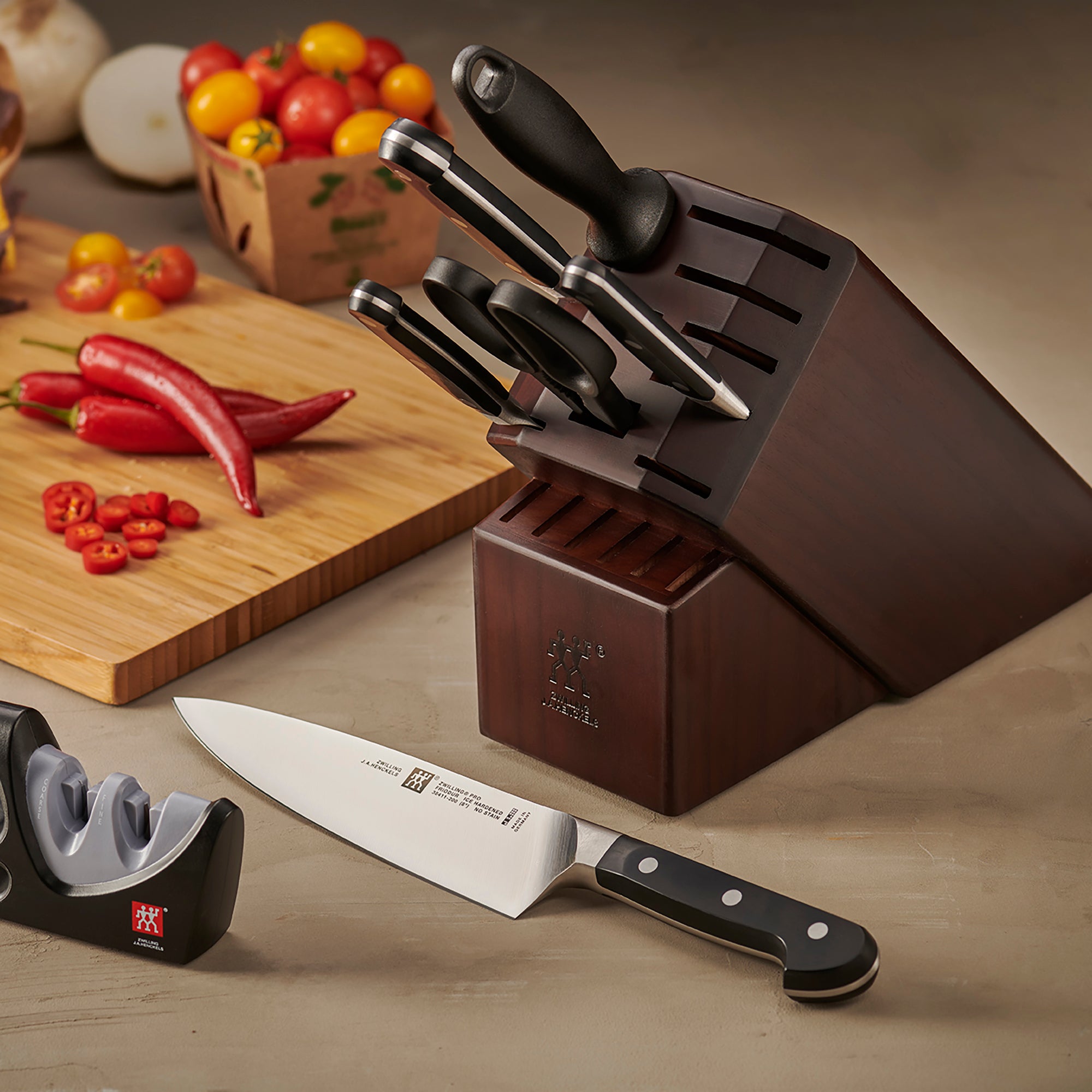
If you are just starting off on a new culinary adventure in life, and don’t want to overdo it, the previously mentioned knives are a good start. And most manufacturers either offer a starter set of chef’s, bread and paring knife to get you started. This Zwilling J.A. Henckels Pro 3-Piece Starter Knife Set is a perfect example. These 3 knives are forged from a single piece of high carbon and ice-hardened stainless steel. Some chefs would prefer to have a few more options between the 8” chef’s knife and the 3” paring knife. This Global Classic 7-Piece Takashi Knife Block Set is a perfect filler for that size gap. It includes a 4.25” utility knife and a 5.5” vegetable knife. It also has a sharpener and a knife block, hence the 7 pieces. Most manufacturers carry knife block sets that have a couple more sizes of serrated knives in between the chef’s knife and the paring knife. Those usually come in the form of a 10-piece set. And if you are a steak loving household, you can get sets that include steak knives. Those can come in as many as a 20-piece set. Steak knives are also sold in separate sets if you’d like to add those to your collection later. The more knives the better too for this very practical and less textbook reason. They are never all clean when you need them.
3. Do I need a knife block?
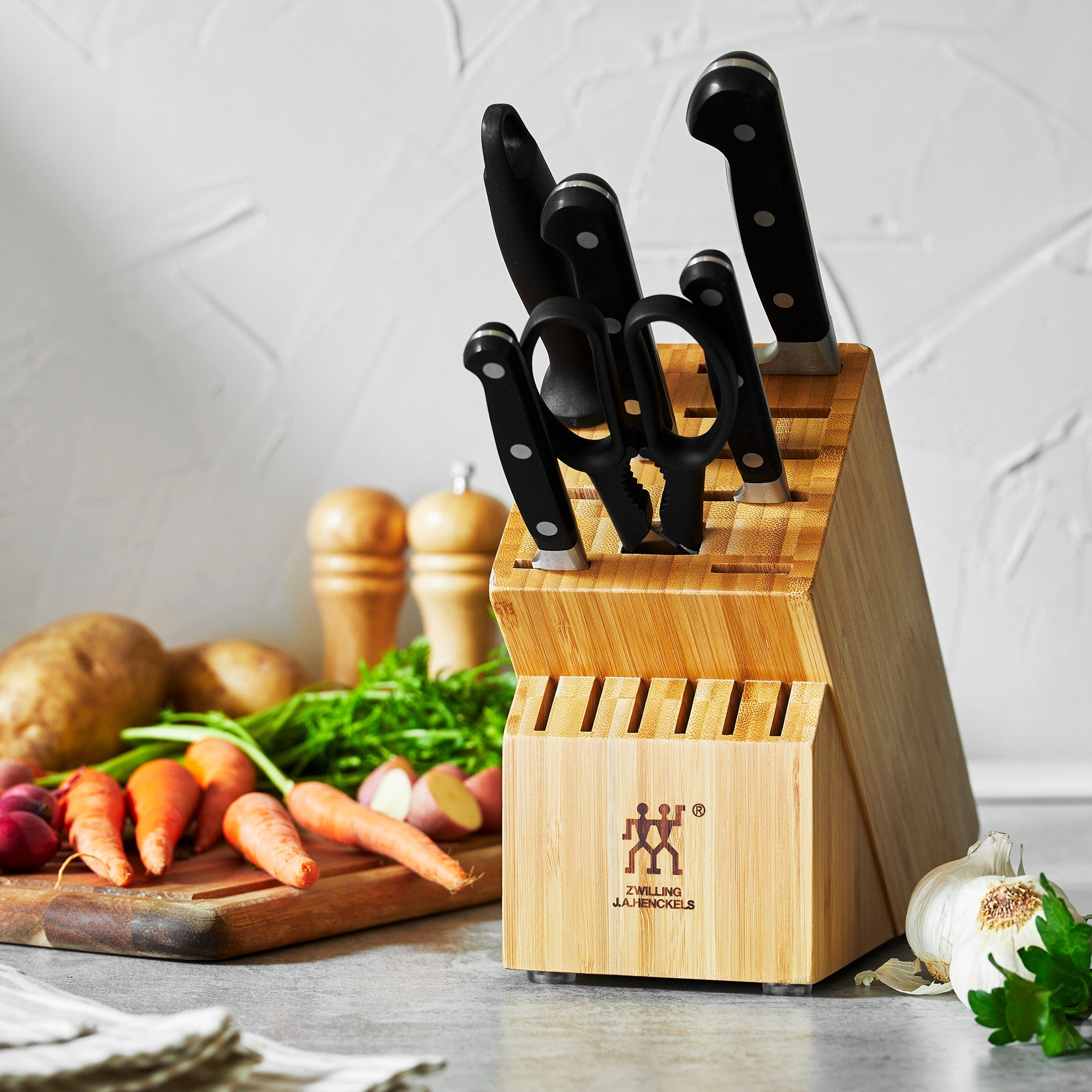
Yes. Well, let’s put it this way. You need something to store your knives. You really don’t want your nice knives jangling around in your general pop flatware drawer. They will get beaten up and dull. You don’t put your jewelry in your nightstand, do you? Okay, your nice jewelry. And quite frankly, sharp knives in an everyday drawer can be a little dangerous. You should store your knives in a knife block (next section), a mounted magnetic bar or a presentation box.
4. Are there any trends I should know about?
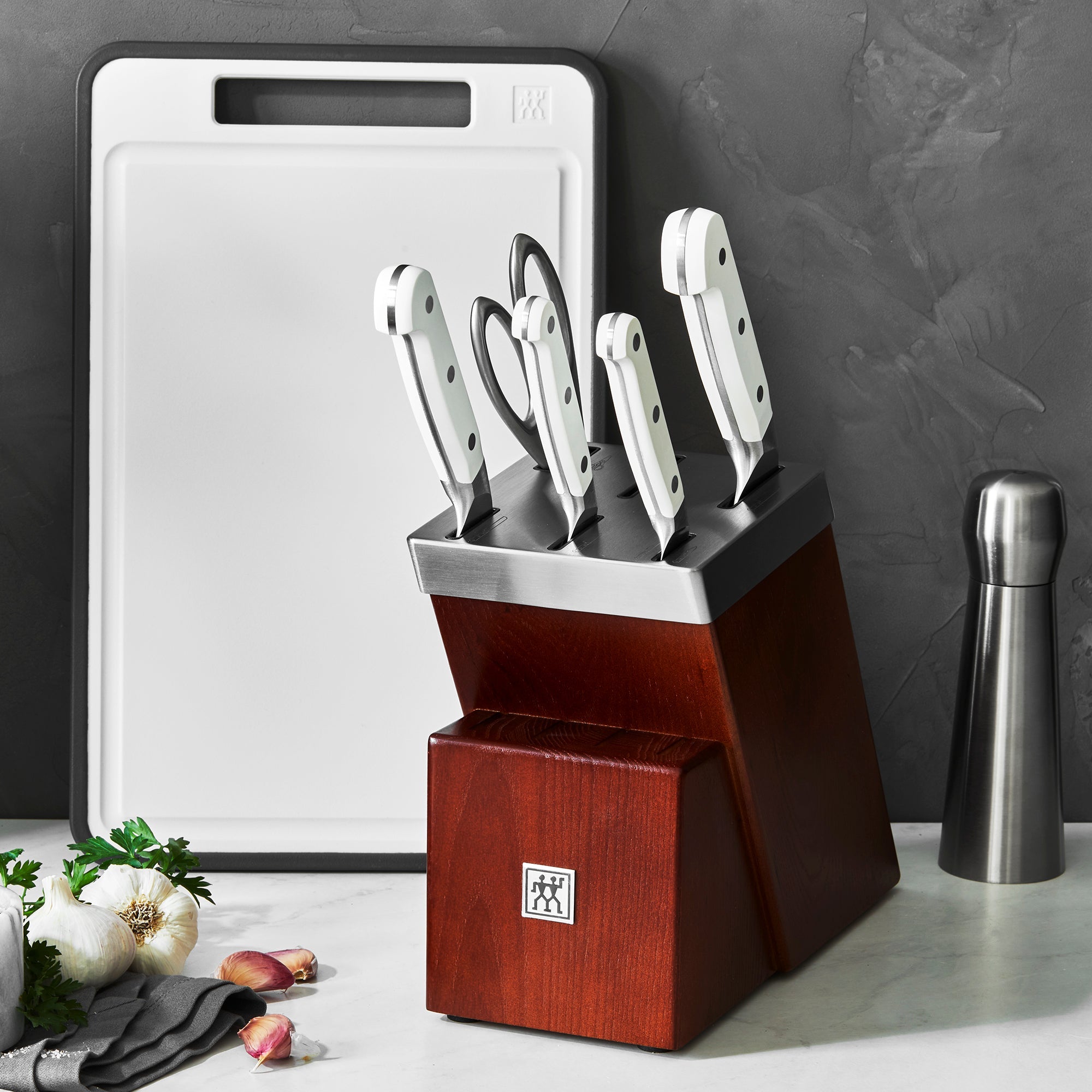
Most trends in knives come from the materials around the actual blades. The species of wood for the wood blocks. Birch and bleached woods are a popular choice as well as some darker walnuts. So are knife blocks that self sharpen. Colorful and white handled knives like the Zwilling Pro Le Blanc 7-Piece Self-Sharpening Knife Block Set are also a new trend. Magnetic strips, presentation boxes and leather carrying cases are also trending in the knife world. Colorful blades are also trending. They are beautiful, but most get their color from a titanium coating. Titanium is corrosion resistant, and very lightweight, it’s just not a great hard-enabled blade material. Those rainbow knives are still stunning. And Selena uses them, so there’s that.
5. How do I store my knives?
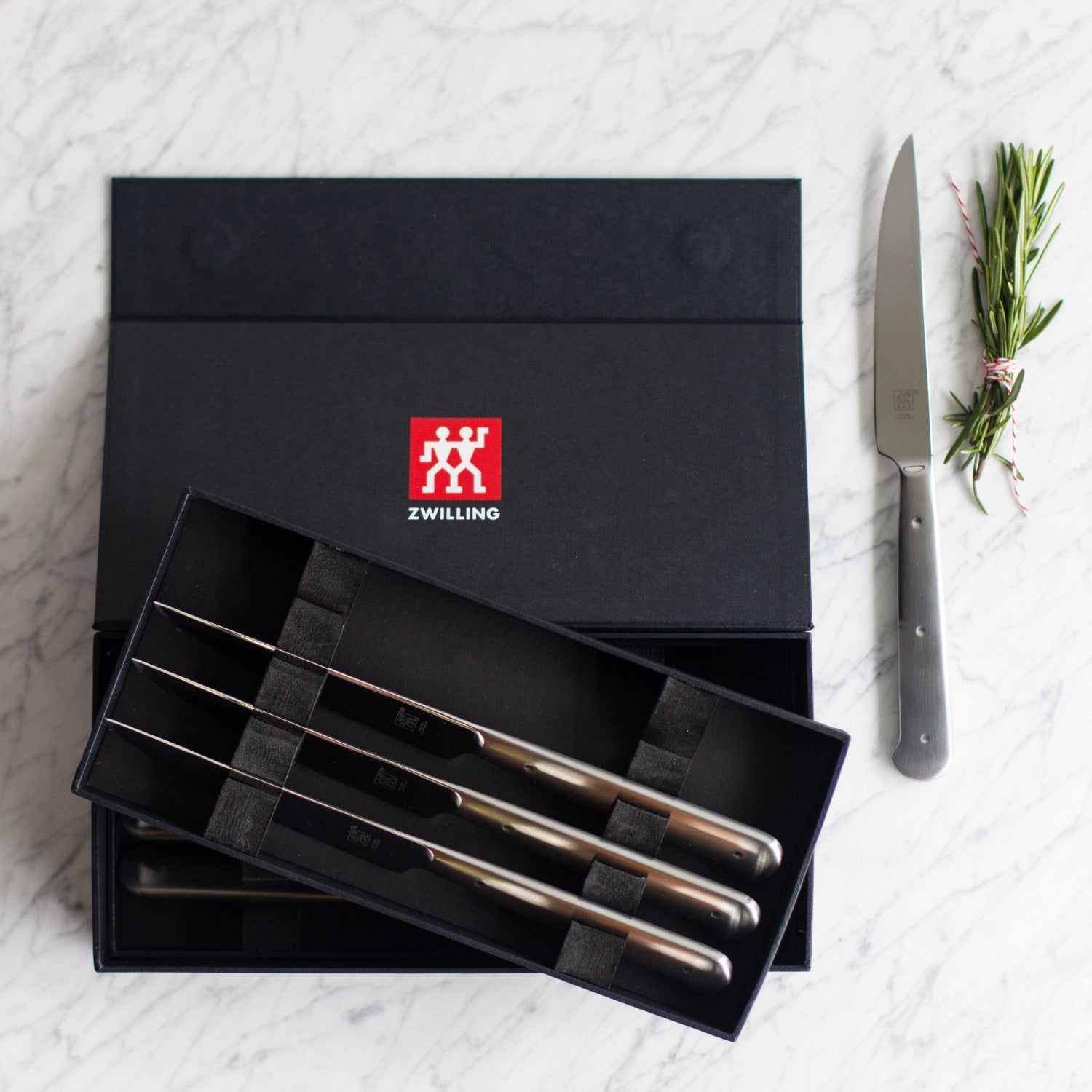
NOT in your nicely organized flatware drawer! It’s a recipe for damaging and dulling blades and possibly a trip to the ER. They make knife blocks for a reason. Knife blocks are a pretty universally awesome solve for knife storage because there is almost always room for more. And you can add to your sets. Presentation boxes are another good storage solution. They are usually designed for a set of steak knives like this Zwilling Toro 4-Piece Steak Knife Set in Beechwood Presentation Box. This leather travel case from Zwilling is also a nice way to store your steak knives at home or on the road.
6. How do I clean my knives?
Always, ALWAYS, hand wash your knives. Just soap and water. A non-abrasive scrub brush is okay. But by all means, do not put them in the dishwasher. The extreme high temperatures and the movement and clanking around alone can seriously damage your blades. Google, “what’s the quickest way to destroy my chef’s knife?” See?
7. Does appearance matter?

As with anything on your kitchen countertop, appearance absolutely matters. Everyone’s seen a prototypical knife block. And if that’s what you are looking for, there are a bajillion options. Wood or black knife handles in a medium colored wood block are the most popular knife block sets for a reason. Maybe ivory handles would be a better visual surprise for your kitchen. Maybe a pop of color. Maybe a white or bleached wood matches the other woods in your space. Maybe you think it’s a bit more of a modern take to get a magnetic bar to place your knives along your backsplash. Sometimes just the sheer amount of knives displayed in your kitchen makes a visual statement that means, I take this cheffing stuff pretty seriously. Appearance matters, but that’s entirely up to you.
8. Does material matter?
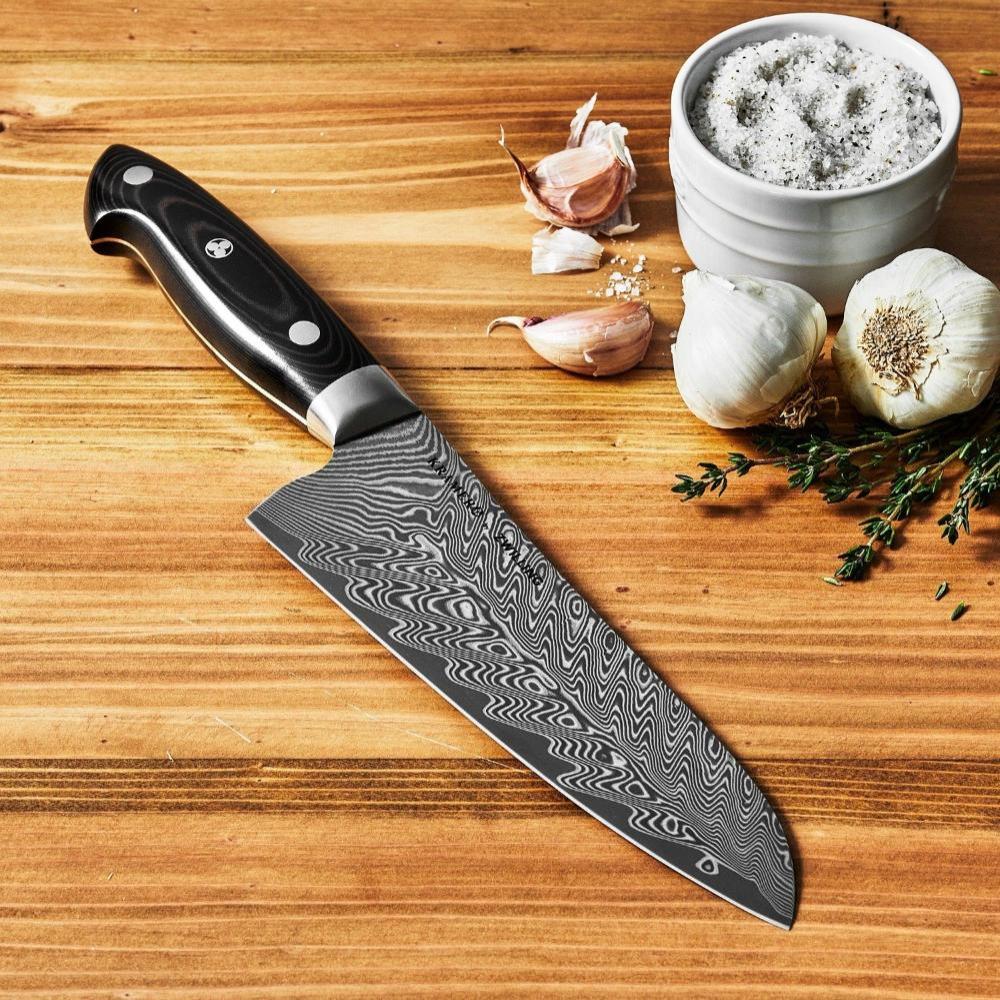
Absolutely. And we could write an entire separate post on ceramic vs. stainless vs. carbon vs. damascus steel. So here is the “as brief as we possibly can” version.
Ceramic - lightweight, able to be manufactured extremely sharp. It can be brittle and breakable.
Stainless Steel - strong, resistant to corrosion, affordable yet can hold a really sharp edge.
Carbon Steel - the standard for kitchen knives. Rates very high on sharpness, corrosion-resistance and edge retention.
Damascus Steel - the platinum standard. This is not a special metallurgical recipe. It refers more to a process of folding and hardening metals together to create the hardest knife you should really even need in your kitchen. If you see the extreme wavy lines in the face of the blade, that’s usually damascus steel. Usually.
All of these elements, metal cocktails and alloys can be graded by hardness on the Rockwell scale. You can look that up. And most manufacturers have their own special proprietary mixes just to keep us all on our toes.
9. What else do I need to care for my knives?
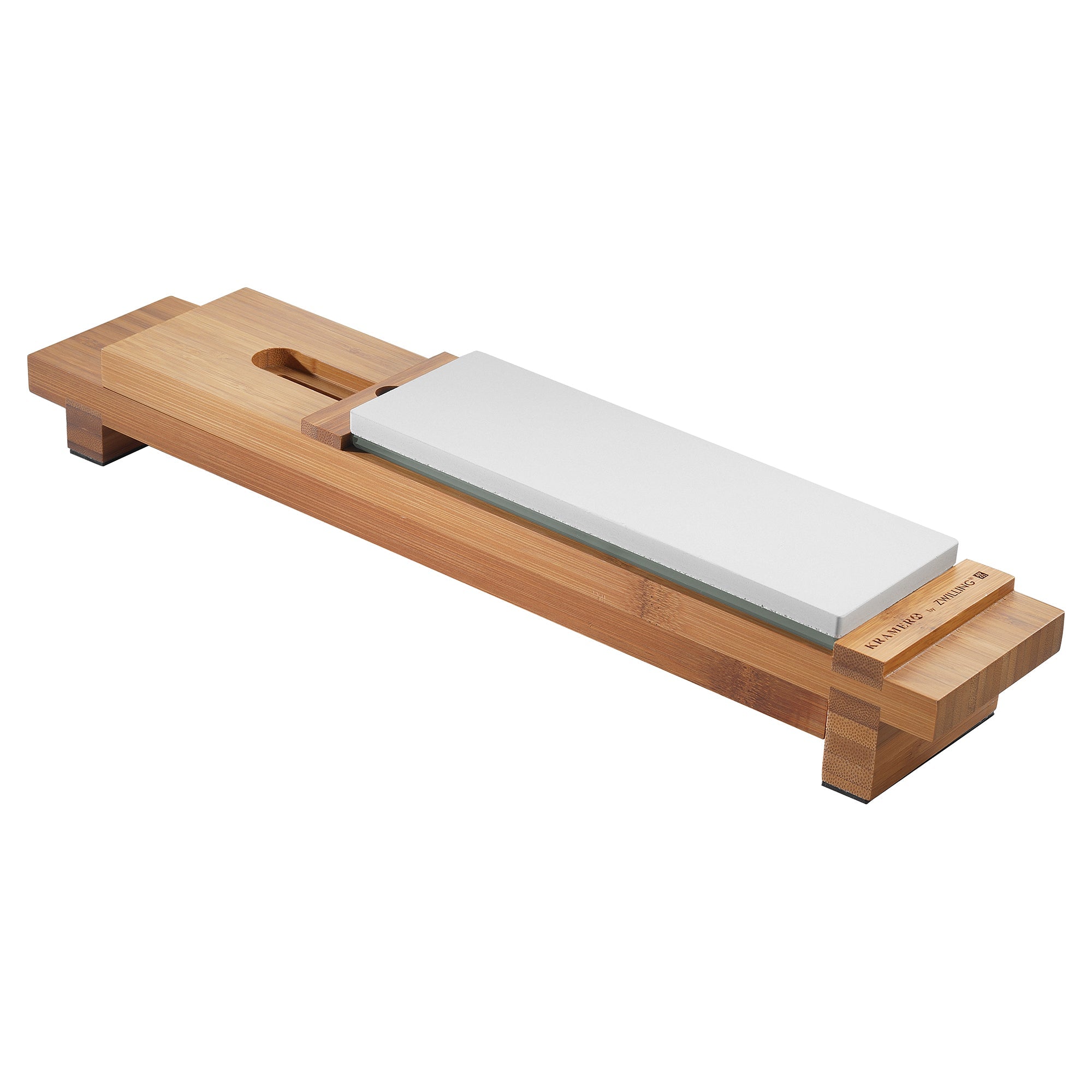 As we mentioned before, something to store your knives in, or on, is very important. Try this new and equally fantastic Zwilling Italian Round Magnetic Knife Block. The right wood or plastic cutting board is essential in caring for your knives. Try any end-grain wood cutting board from Larch Wood. DO NOT use steel or glass cutting boards please. There are sharpeners and sharpening stones like this Kramer Bamboo Sharpening Stone Sink Bridge.
As we mentioned before, something to store your knives in, or on, is very important. Try this new and equally fantastic Zwilling Italian Round Magnetic Knife Block. The right wood or plastic cutting board is essential in caring for your knives. Try any end-grain wood cutting board from Larch Wood. DO NOT use steel or glass cutting boards please. There are sharpeners and sharpening stones like this Kramer Bamboo Sharpening Stone Sink Bridge.
10. What knives do celebrity chefs use?
We get asked this one a lot. And of course that depends. There are celebrity chefs that have been doing this their whole lives like Gordon or Giada. There are new celebrity chefs that were a celebrity before they ever picked up a knife like Selena. And there are chefs that we see on TV like Carmy from The Bear. There has been a pretty solid curiosity about what knife he is using since that show aired btw. The simple answer is usually this: some version of a classic chef’s knife. By the time they become celebrities, they are either working on, or have endorsements with different brands. That doesn’t mean they don’t love or believe in the knives they chose. Because they probably did actually choose them. It’s just really hard for us to say any of the knives they endorse are better than the other. Sorry! That’s just how it mostly works nowadays. But they definitely all start with some version of a chef’s knife.






